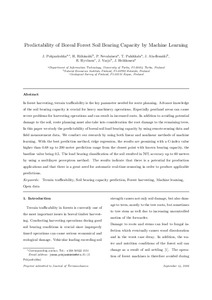Predictability of boreal forest soil bearing capacity by machine learning
J. Pohjankukka; H. Riihimäki; P. Nevalainen; T. Pahikkala; J. Ala-Ilomäki; E. Hyvönen; J. Varjo; J. Heikkonen
Predictability of boreal forest soil bearing capacity by machine learning
J. Pohjankukka
H. Riihimäki
P. Nevalainen
T. Pahikkala
J. Ala-Ilomäki
E. Hyvönen
J. Varjo
J. Heikkonen
PERGAMON-ELSEVIER SCIENCE LTD
Julkaisun pysyvä osoite on:
https://urn.fi/URN:NBN:fi-fe2021042716099
https://urn.fi/URN:NBN:fi-fe2021042716099
Tiivistelmä
In forest harvesting, terrain trafficability is the key parameter needed for route planning. Advance knowledge of the soil bearing capacity is crucial for heavy machinery operations. Especially peatland areas can cause severe problems for harvesting operations and can result in increased costs. In addition to avoiding potential damage to the soil, route planning must also take into consideration the root damage to the remaining trees. In this paper we study the predictability of boreal soil load bearing capacity by using remote sensing data and field measurement data. We conduct our research by using both linear and nonlinear methods of machine learning. With the best prediction method, ridge regression, the results are promising with a C-index value higher than 0.68 up to 200 m prediction range from the closest point with known bearing capacity, the baseline value being 0.5. The load bearing classification of the soil resulted in 76% accuracy up to 60 m by using a multilayer perceptron method. The results indicate that there is a potential for production applications and that there is a great need for automatic real-time sensoring in order to produce applicable predictions. (C) 2016 ISTVS. Published by Elsevier Ltd. All rights reserved.
Kokoelmat
- Rinnakkaistallenteet [27094]
